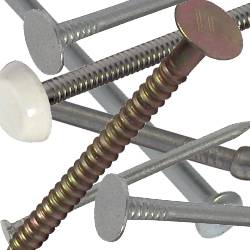What Is The Difference Between Screws And Nails?
Both screws and nails have been very popular fasteners for many years and they are each essential in particular situations. They both have their uses, but there are times when one is better than the other. Screws and nails are very well-established types of fastener, but the nail is perhaps the most traditional and for years was by far the more popular, mainly because they were faster and easier to use, and cheaper to buy. After all, you just need a hammer and some brute force. But the advent of things like the Phillips screwdriver, and particularly power tools like the portable cordless screwdriver, have increased the user-friendly nature of screws too.
Now, it is possible to use both screws and nails for many similar applications, and as long as you use the right type, size and tool, you will achieve the kind of fastening you need, but technology has evolved to create more specific types of screws and nails and more specific tools. So now we can find screws specially for wood, plasterboard and masonry, for example, while nails also come in various shapes and sizes tailored to specific jobs. So let’s look at different applications and where and why either the screw or the nail is more appropriate to use, but first let’s explain how they are different.
The physical characteristics of screws and nails

- Nails – nails usually have a round, flat head and a pointed tip at the end of the shaft. This enables them to be hammered into a material to provide a hold or to join two items together. Nails can be made from different materials and with different finishes, but generally, they are cheaper than screws because of this simple design. Nails have a good shear strength, meaning they can withstand shear pressure and may bend in shape, but will not snap. So nails aren’t brittle and provide a good hold for two surfaces which may slide past each other.
- Screws – screws can have a variety of different shaped-heads, such as round, flat, oval, countersunk and have different ends for the use of different tools, ie. slotted or crossed/Phillips. Screws also have a shaft but this is usually fully or partly threaded. This thread helps the screw drive into a material to provide the hold. Screws have a superior tensile strength compared to nails, which means they can draw materials closer together to form a tighter joint. The thread on a screw provides a better resistance to withdrawal pressure than a nail, but this also means that screws are easier to remove out of materials (with a screwdriver working in reverse) should you need to.
Where would you use a nail vs where would you use a screw?
We have already established that screws provide a better hold when driven into materials, because of the thread. So screws are better to use when joining materials that are under tension or are bearing weight. Screws are popular for wood-to-wood joints, and for constructing wood-working furniture such as cabinets and chairs. There are special screws for fixing plasterboard, while screws for decking are also popular because of the stronger holding power. This holding power also gives screws an advantage for items such as sub-floors, where you want a hold to be firm and not bouncy or squeaky.
Generally speaking, any fastener that needs to be longer than around 25mm should be a screw, because the thread and the diameter of the shaft will provide the additional strength that is needed. Nails aren’t usually made longer than this, but nails still have plenty of uses. Because nails are typically much cheaper than screws, they are good for jobs where lots of fasteners are needed and they are all doing the same job. So this would include exterior jobs such as roofing, sheathing and attaching housing trim such as fascias. Internally, hardwood flooring would use nails because you want some flexibility and a bit of bounce, and, importantly, nails provide an aesthetic benefit. Because nails are hammered into a material so that they finish flush, they are less visible and don’t sit proud. So nails are good for internal mouldings and skirtings, because they are more discreet and don’t mark the wood like the head of a screw would.
Choosing the right fastener for your application
So both the screw and the nail are perfectly good fasteners, but you are advised to ensure you are using the right type and size of fastener and the correct tool. Both screws and nails can be used internally and externally, and indeed, they can both be coated as such to withstand weather deterioration. The main difference comes in cost, but also the ease of application and the eventual type of hold that is required. This is where a certain type of screw or nail may hold an advantage.
If you contact our team at MB Direct we can advise on the best fasteners for any job and select the right one for you from our range of screws and fixings range.